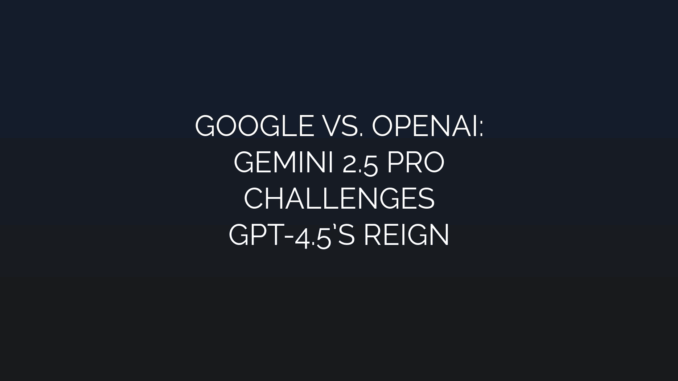
The Generative AI Titans: A New Chapter Unfolds
The rivalry between Google and OpenAI has entered a pivotal phase with the debut of Gemini 2.5 Pro, Google’s most advanced large language model (LLM). This release directly challenges GPT4.5, OpenAI’s flagship model, intensifying the race for AI supremacy. As enterprises and developers seek cuttingedge generative AI tools, these two giants are pushing the boundaries of natural language processing, multimodal reasoning, and realworld application scalability.
Evolution of the Giants
OpenAI’s trajectory from GPT3 to GPT4.5 established it as the benchmark in generative AI. GPT4.5 refined its predecessor’s capabilities, excelling in logical reasoning, code generation, and nuanced text synthesis. Its integration with Microsoft’s ecosystem and the ubiquitous ChatGPT interface fortified its market dominance.
Meanwhile, Google accelerated its AI ambitions with the Gemini series. Gemini 1.0 laid the groundwork, but the iterative Gemini 1.5 and 2.5 Pro models marked a quantum leap. Leveraging Google’s proprietary TPU v5 infrastructure and novel architectural innovations like mixtureofexperts (MoE), Gemini 2.5 Pro targets bottlenecks in efficiency, context handling, and multimodal processing where competitors falter.
Breaking Down the Contenders
Gemini 2.5 Pro: Google’s Technical Masterstroke Google engineered Gemini 2.5 Pro for three transformative advantages:
- Unprecedented Context Window: A groundbreaking 1-million-token context capacity enables analysis of vast datasets—entire codebases, lengthy legal documents, or hours of video—without fragmentation.
- Multimodal Precision: Unlike hybrid approaches, Gemini 2.5 Pro natively processes text, images, audio, and video within a unified architecture, enhancing contextual coherence.
- MoE Efficiency: Dynamic routing directs queries to specialized neural subnetworks, slashing computational costs while maintaining fidelity in outputs.
These features position Gemini 2.5 Pro as an enterprisegrade solution for datadense industries like healthcare, finance, and media.
GPT4.5: OpenAI’s Refined Performer GPT4.5 builds on OpenAI’s transformerbased heritage with incremental yet impactful upgrades:
- Enhanced Reasoning: Superior performance in complex logical reasoning tasks, including mathematical proofs and scientific analysis.
- Ecosystem Synergy: Tight integration with Microsoft Copilot and Azure, streamlining adoption for enterprise workflows.
- Developer Familiarity: Broad compatibility with OpenAI’s API and a mature plugin ecosystem lowers migration barriers.
While GPT4.5 retains strengths in creative text generation and conversational fluidity, its 128K token context window pales against Google’s 1milliontoken benchmark.
Performance Comparison: Benchmarks and Real-World Use
Independent evaluations highlight distinct competitive edges:
Reasoning and Knowledge Mastery
- MMLU (Massive Multitask Language Understanding):
- GPT-4.5 leads marginally (89.7% vs. Gemini 2.5 Pro’s 88.9%) in broad knowledge tasks.
- HumanEval (Coding):
- Gemini 2.5 Pro edges ahead (80.2% vs. 79.5%) with superior code optimization capabilities.
Multimodal Prowess Gemini 2.5 Pro dominates multimodal artificial intelligence benchmarks:
- VideoQA (Video Question Answering): 85% accuracy (vs. GPT-4.5’s 76%).
- Audio transcription & sentiment analysis: Near-human parity in noisy environments.
Efficiency and Scalability Google’s MoE architecture allows Gemini 2.5 Pro to deploy smaller active parameter sets during inference, reducing latency by 40% compared to GPT4.5’s dense model structure.
User Experience: Accessibility and Integration
- Gemini 2.5 Pro: Deeply integrated into Google Workspace, Vertex AI, and Firebase. Offers a free tier with scalable pricing for high-volume API usage.
- GPT-4.5: Available via ChatGPT Plus, Azure OpenAI Service, and a pay-per-use API. Benefits from OpenAI’s polished UX but faces criticism for opaque rate limits.
For developers, Gemini’s OpenGemini libraries simplify deployment, while OpenAI’s established community fosters rapid troubleshooting.
Market Implications
The Gemini 2.5 Pro launch disrupts three key sectors: 1. Enterprise Solutions: Industries handling massive unstructured data (e.g., genomics researchers, media archivists) lean toward Google’s longcontext model. 2. Consumer AI: OpenAI retains mindshare in creative applications via ChatGPT’s userfriendly interface. 3. Cloud Wars: Google Cloud leverages Gemini to challenge Azure’s OpenAI integrations, forcing competitive pricing and feature rollouts.
The Road Ahead
Both behemoths face pressing challenges:
- Ethical AI: Mitigating hallucinations and bias remains a shared priority.
- Cost vs. Capability: Scaling generative AI affordably is critical for mainstream adoption.
- Regulation: Evolving global AI policies could reshape deployment strategies.
Google’s roadmap hints at Gemini Nano optimizations for edge devices, while OpenAI focuses on AGIaligned safety protocols.
Conclusion: A Shifting Landscape
Google’s Gemini 2.5 Pro has irrevocably disrupted the LLM status quo, compelling OpenAI to accelerate innovation beyond GPT4.5. With distinct strengths—Google in scalability and multimodal depth, OpenAI in reasoning and ecosystem maturity—the competition fuels unprecedented advancements in artificial intelligence. For users, this rivalry translates to more powerful, efficient, and accessible tools, cementing generative AI as the cornerstone of digital transformation. As both titans race toward artificial general intelligence, one truth emerges: the real winner is the future of intelligent computing itself.
Leave a Reply